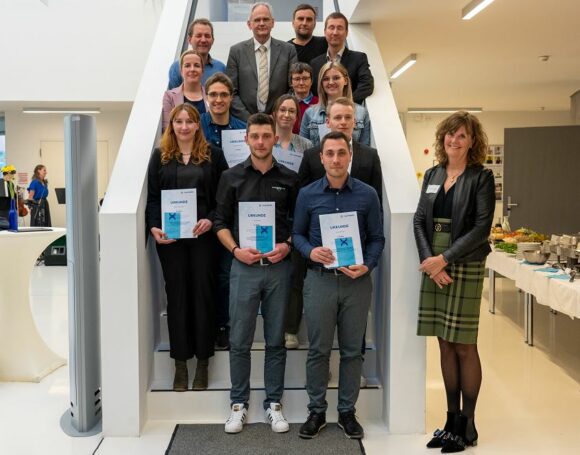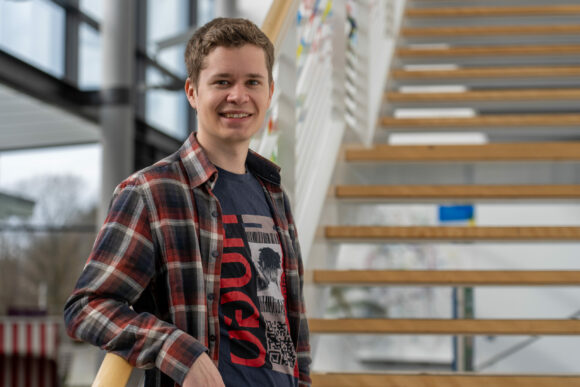A year ago, the new Design & Mobility course, which deals with the future of transportation, was launched at the Selb Learning Center of Hof University of Applied Sciences. Prof. Lutz Fügener, an internationally recognized expert in transportation design and 3D design, was recruited to set up the course, which was initiated in collaboration with the Staatliche Fachschule für Produktdesign Selb, and his move to Upper Franconia attracted a great deal of attention at the time. After the first two semesters, he is very satisfied with what has been achieved so far.

A lot has happened in the Spiegelhaus of the Rosenthal company in Selb: Since the winter semester 2021/22, the interdisciplinary course of study “Design and Mobility” at Hof University of Applied Sciences has been at home here. A total of 25 students, internally referred to as “alpha semesters,” are dealing there with questions relating to the mobility of the future. In addition to the pure design of future vehicles, for example, the constantly changing user behavior is also integrated into teaching and training. Setting up the new program at Hof University of Applied Sciences naturally proved to be a challenge.
Announcement succeeded
When Prof. Lutz Fügener took over the professorship, there was already complete planning in terms of the basic orientation of teaching in the degree program, subjects and teaching content. For him, however, the task was to fill the framework with life and with concrete content, and finally to implement it didactically and organizationally. “Thus, on the one hand, there were still requests for changes in content, which were sharpened. On the other hand, of course, it was important to make the course known in industry and business and to arouse interest,” says Prof. Lutz Fügener. The latter was undoubtedly successful, but “design can only be communicated on the basis of creative results,” which of course still have to be created in part. “But we have already worked hard on this over the past year,” says the course director. Two semesters have now been successfully completed, he said, and the program has proven its worth. For example, he said, there are already collaborations with two well-known industrial companies and a start-up, which is why it is already possible to demonstrate relevance of the design work at an unexpectedly early stage.
Second professorship about to be named
If all goes well, another professorship assigned to the program can be filled starting in November 2022. According to Prof. Fügener, “an outstanding personality” has been recruited for this position, although the name of this person may only be mentioned in due course. In the coming semesters, the program’s profile will be further sharpened, additional cooperation with industry will be established and the program will also be made known internationally. “We still have a lot of work ahead of us to increase the number of prospective students bit by bit. There is a correlation between the quality of the program’s work and the widespread impact and attractiveness of our education. We are slowly working our way up,” admits Lutz Fügener.
Existing in international competition
According to him, another important goal in addition to attracting students results from the course of study, which provides for an industrial internship for the first students starting in the winter semester of 2023: “This will be an important indicator of the success of our work. We will then see whether the students can also win internships in the international competition.
So far, at any rate, the feedback from the students has also been consistently positive: “Our first students are aware of the special situation and the associated pioneering work for the course. They have accepted this situation very constructively and have actually developed a sense of responsibility for the entire project. This has led to a very positive atmosphere in teaching and beyond,” reports the delighted course director.
Selb location well received
And the Selb learning site, which was inaugurated last year at a ceremony in the Rosenthal Theater, is also increasingly popular. Many students already have experience of the city and the surrounding area, which they can share with others, making it easier for newcomers to settle into their new environment. Even away from the classroom, the program does a lot together to explore the surrounding area, he said. “I have the feeling that the location is well received,” Prof. Fügener said.
Asked about his own experience, the course instructor also responds positively:
Personally, I am very happy to be able to work on this project! It is a great challenge, requires team spirit, innovative ideas and their creative implementation. And we are making progress. Here – both at the university and in the city and district – we find open ears and doors everywhere. The area is also very attractive. And last but not least, a new start like this is always a kind of fountain of youth.”
Prof. Lutz Fügener
In spring 2023, the application phase for the admission of students in the study program “Design and Mobility” will begin for the winter semester 2023/24.
About the Design and Mobility program:
The bachelor’s degree program in Design and Mobility strives to find new answers to a basic need of humanity: mobility. A major industry is on the move; profound changes are giving rise to entirely new forms of mobility. Digital tools make it possible to redesign the real world. The course works in intensive exchange with relevant partners in the mobility industry. The focus and goal of the course is to train young designers who want to face the design and technical challenges of the mobility of the future in their professional lives. Thematically, the study program spans a wide range from classic means of transport such as the automobile, the muscle and motor-driven two- and three-wheeler, air and water vehicles, to the broad field of new forms of mobility tools and their intermodality, to concepts for the transformation of infrastructures and scenarios of mobile life.
The educational program is designed to train and put into application different points of contact between design and engineering. For this purpose, the study program contains both design and engineering subjects. Graduates should be able to communicate and act across disciplines in an industrial environment and in independent work, and thus be able to work creatively and successfully in heterogeneous project teams and make a valuable contribution to shaping the mobility requirements of the future.







